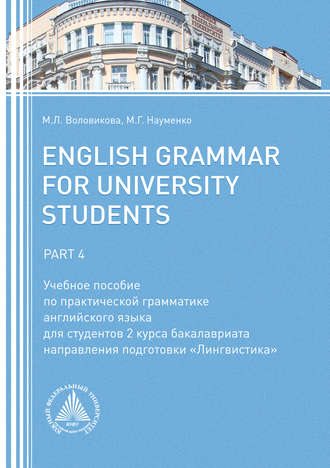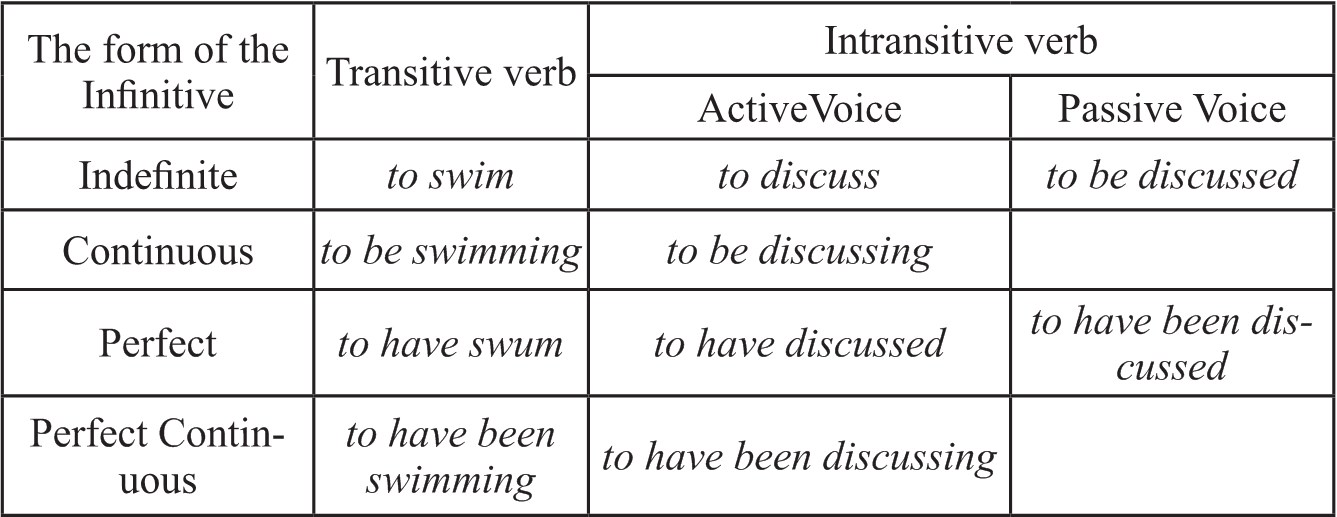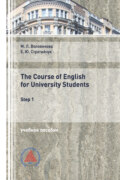
М. Л. Воловикова
English Grammar for University Students. Part 4
Пояснительная записка
Учебное пособие разработано на компетентностно-модульной основе с интеграцией существующих программ подготовки бакалавра на основе действующего Государственного образовательного стандарта высшего профессионального образования и документа «Общеевропейские компетенции владения иностранным языком: изучение, обучение, оценка».
Компетентностный подход в языковом образовании опирается на коммуникативный и личностно-ориентированный подходы. Конечным результатом образовательного процесса в рамках компетентностного подхода является развитие иноязычной коммуникативной компетенции студента и всех входящих в нее субкомпетенций, модуль является средством организации учебного процесса. Это позволяет сделать процесс обучения индивидуализированным, доступным и ясным.
Материал пособия отражает темы, изучаемые в курсе практической грамматики английского языка в III–IV семестрах бакалавриата по направлению Лингвистика. Изучение практической грамматики в III–IV семестрах охватывает продвинутый этап развития иноязычной коммуникативной компетентности, соотносящийся с уровнем В2 «Общеевропейских компетенций…». На этом этапе формируются основные навыки, обеспечивающие языковую и коммуникативную подготовку лингвиста.
К концу четвертого семестра обучения на продвинутом уровне студент должен:
– грамотно употреблять в устной и письменной речи определенное количество стандартных конструкций, связанных с более или менее предсказуемыми ситуациями;
– уметь различать стилистические и прагматические особенности ситуации и производить выбор изученной грамматической структуры;
– уметь передать оттенки значения разными синонимичными грамматическими средствами;
– уметь анализировать функциональные особенности каждой грамматической структуры и давать правильный перевод с/на русский язык;
– переводить с русского языка на английский и с английского на русский сложные ситуации, содержащие несколько коммуникативных линий в рамках изученной тематики, а также тексты, принадлежащие к различным сферам деятельности: общественно-политической, деловой, спортивной, культурной, образовательной, и т. д.;
– спонтанно переводить с русского языка на английский ситуации, содержащие пройденный лексический и грамматический материал [Формирование иноязычной коммуникативной компетентности лингвиста-переводчика на основе проектов ФГОС ВПО третьего поколения и общеевропейских стандартов языкового образования, 2010].
Коммуникативная компетенция после овладения продвинутым уровнем включает в себя определенный набор знаний, умений и навыков.
Знания:
– понятийного аппарата практической грамматики;
– основных грамматических явлений и закономерностей функционирования изучаемого языка;
– особенностей официального, нейтрального и неофициального регистров общения.
Умения:
– проводить сравнительно-сопоставительный анализ лингвистического материала;
– употреблять определённые грамматические структуры в зависимости от ситуации общения и цели высказывания;
– владеть основными способами выражения коммуникативной и структурной связи между композиционными элементами текста;
– дифференцировать модели и структуры, характерные для разных стилей языка, устной и письменной речи;
– осуществлять сопоставительный анализ языка источника и языка-перевода, учитывать расхождения в грамматическом аспекте;
– создавать развернутые логично построенные тексты.
Навыки:
– грамотно использовать устную и письменную речь;
– использовать дискурсивные способы реализации коммуникативных целей высказывания;
– определять значение и функции языковых явлений в тексте;
– анализировать простое предложение в составе оригинальных текстов, выявлять типы связи;
– переводить с русского на английский и с английского на русский язык предложения и тексты, содержащие пройденный грамматический материал.
Module 1. The infinitive
NON-FINITE FORMS OF THE VERB. GENERAL CHARACTERISTICS
Verb forms fall into two classes: finites and non-finites, the latter are also called verbals, verbids. There are four non-finite forms of the verb in the English language: the Infinitive, the Present Participle (Participle I), the Past Participle (Participle II), and the Gerund.
Non-finite forms of the verb have double nature, they possess the characteristics of the verb together with the characteristics of other parts of speech. They have some verbal categories: voice, aspect, and temporal correlation; but they lack the categories of person, number, mood, and tense [Кобрина,Корнеева, 2009].
The verbal nature of non-finite forms is also revealed in combinability. Similar to finite verbs they may take direct, indirect, and prepositional objects, adverbial modifiers, and subordinate clauses.
Verbals cannot be a predicate in the sentence but they can be used as part of a compound predicate. They may form predicative constructions which consist of two elements: a noun or a pronoun and a verbal. They are in predicative relation that resembles the relation of the subject and the predicate.
I would like you to play with the child.
I saw him cross the street.
Father had his car repaired yesterday.
The non-verbal nature of non-finites may be seen in their syntactical functions. The Infinitive and the Gerund perform the syntactical functions of subject, object and predicative that are similar to the syntactical functions of the noun. Participle I may function as part of a compound nominal predicate (predicative), attribute, and adverbial modifier; Participle II may function as attribute and predicative.
THE INFINITIVE
The Infinitive is the form of the verb which expresses a process in general, and is known as the initial form of the verb.
The Infinitive may be used with the particle to. Sometimes the particle is separated from the Infinitive by other words, e.g. an adverb (split Infinitive).
This separation is usually used for the purpose of emphasis.
You have to really watch him.
Historically, the Infinitive is a verbal noun. That is why it combines the features of the verb with those of the noun.
The verbal features of the Infinitive are manifested in its morphological and syntactical characteristics.
1. It possesses the grammatical categories of voice, aspect and temporal correlation.
It was too dark to read the map and we took the wrong turning.
You’re not supposed to be reading this.
Fleming, Tolkien and CS Lewis are the authors that British people most claim – falsely – to have read.
This is a book to be read by everybody taking this course!
Why do some new messages appear to have been read when I haven’t opened them yet?
She was seen to have been reading the new book in the garden.
2. The Infinitive possesses the verb combinability:
a) The Infinitive of transitive (переходные) verbs takes a direct object.
Alex may send (transitive verb) a postcard (direct object) from Argentina.
3. The Infinitive can be modified by adverbials.
She agreed to leave the room quickly and quietly.
The nominal character of the Infinitive is manifested in its syntactical functions.
To drive fast in such weather is pretty dangerous (subject).
Their duty will be to look after the children (predicative).
I asked her to explain everything (object).
I have no desire to go there (attribute).
The grammatical categories of the infinitive
The Infinitive possesses verbal categories: temporal correlation, aspect, and voice (for transitive forms) (as shown in the table below) [Тивьяева, 2007].
FORMS OF THE INFINITIVE

As for temporal correlation, the forms of the Infinitive show whether the action is simultaneous to the action expressed by the finite verb, or prior to it.
1. The Non-Perfect (Indefinite, Simple) Infinitive denotes an action simultaneous with that of the finite verb.
Jeremy likes to write letters.
Jeremy liked to write letters.
Jeremy will like to write letters.
2. The Continuous Infinitive expresses an action in progress or happening over a period of time and simultaneous with that of the finite verb. The Continuous Infinitive is both a temporal and aspect form, becauseit expresses how an action, denoted by the Infinitive, extends over time.
You must be joking.
I happened to be waiting for the bus when the accident happened.
3. The Perfect Infinitive denotes an action prior to that of the finite verb.
Lucy was known to have left the day before.
I am happy to have finished school.
If you had run faster you would have won the race.
4. The Perfect Continuous Infinitive denotes an action in progress or happening over a period of time which is prior to that of the finite verb. The Perfect Continuous Infinitive is both a temporal and aspect form,because it expresses how an action, denoted by the Infinitive, extends over time.
I’m glad to have been living in Barcelona for the last ten years.
But for the fog the travellers would have been wandering in the forest for a long time.
The Infinitive of transitive verbs possesses voice distinctions and has the forms of the Active and Passive Voice.
Please remember to bring a mat and a towel with you to the next aerobics class (Indefinite Active).
He happened to be brought up in a very rich family (Indefinite Passive). President Trump is very proud to have brought the subject of illegal immigration back into the discussion (Perfect Active).
Tomatoes are known to have been brought to Europe in the XVIth century (Perfect Passive).
The active form of the Infinitive shows that the subject of the sentence, the person or thing characterised by the Infinitive, or the person or thing expressed in the Infinitive predicative construction is the doer of the action denoted by the Infinitive.
The passive form of the Infinitive shows that the subject of the sentence, the person or thing characterized by the Infinitive, or the person or thing expressed in the Infinitive predicative construction is affected by the action denoted by the Infinitive [Шрамко, Степанова, Кожемяка, 2008].



